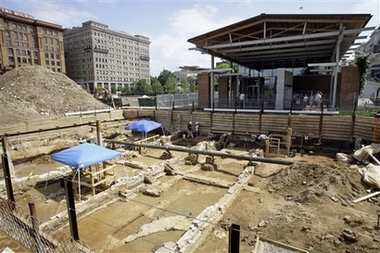Slave passage found at Washington house
PHILADELPHIA - Archaeologists unearthing the remains of George Washington's presidential home have discovered a hidden passageway used by his nine slaves, raising questions about whether the ruins should be incorporated into a new exhibit at the site.
 Shown are the remains of buildings including the house George Washington lived in when he was president at the sight of an archaeological dig in front of the Liberty Bell Center, top right, in Philadelphia, Tuesday, June 5, 2007. [AP] |
"As you enter the heaven of liberty, you literally have to cross the hell of slavery," said Michael Coard, a Philadelphia attorney who leads a group that worked to have slavery recognized at the site. "That's the contrast, that's the contradiction, that's the hypocrisy. But that's also the truth."
Washington lived and conducted presidential business at the house in the 1790s, when Philadelphia was the nation's capital.
The findings have created a quandary for National Park Service and city officials planning an exhibit at the house. They are now trying to decide whether to incorporate the remains into the exhibit or go forward with plans to fill in the ruins and build an abstract display about life in the house.
Making that decision will push back the building of the exhibit, which had been slated to open in 2009. But the oversight committee won't rush into construction, said Joyce Wilkerson, the mayor's chief of staff.
"We never thought we'd be faced with this kind of decision," she said. "We would've been happy to have found a pipe! And so we don't want to proceed blindly or say, 'This isn't in the plan.'"
Rep. Bob Brady, D-Pa., was so moved when he visited the site last week that he declared: "We need to rethink what we're doing here."
"It's astounding, absolutely astounding," Brady said. "I'm going to fight to keep it open, I'll tell you that much."
Aside from the passageway, archaeologists have uncovered remnants of a bow window, an architectural precursor to the White House's Oval Office, and a large basement that was never noted in historic records.
"We actually found a lot more of the remains of the President's House than anyone expected. Myself included," said Jed Levin, an archaeologist with the National Park Service.
Thousands of visitors have been drawn to the ruins, standing on a small wooden platform to gaze down at the house's brick and stone foundation. The public response spurred officials to continue the excavation until at least July 4; it began in March and had been scheduled to end last month.
Archaeologists have served as guides, answering visitors' questions. Cheryl LaRoche, a cultural heritage specialist, said she enjoys educating people about how even a prominent statesman like Washington could own slaves.
"We've been striving to present a balanced view of history that stands apart from what's been taught in history books," LaRoche said.
Most of Washington's slaves lived at his Mount Vernon estate in Virginia. When Washington died in 1799, he had more than 300 slaves. In his will, he arranged for them to be freed after the death of his wife.
Before the ruins were unearthed, officials had planned an exhibit without archaeological findings. The planned design included a framework of the house, LED screens and other audiovisual elements explaining its history, including stories of Washington's slaves.
The remains would crumble if left uNPRotected. If the design included elevators, ramps or stairs to move visitors down into the newly dug ruins, costs would increase significantly.
Coard said he is confident the oversight committee will find the best way to tell the slaves' stories.
"Everybody's on board in terms of seriously considering incorporating the architectural dig into the design," Coard said. "The question now is: Is it doable? Nobody is saying, 'No, it shouldn't be done.'"
David Orr, an anthropology professor at Temple University, has visited the site at least four times. He posted a note on the President's House Web site urging officials to keep the ruins on display.
"It's just fantastic," Orr said. "I can't tell you enough how exciting it is. For years and years and years I've been trying to promote that kind of public archaeology."
相关文章
- 欧美文化:Turkey, Kazakhstan aim to reach 10 bln USD in bilateral trade: president
- 欧美文化:UN chief condemns attacks on civilians by armed group in DRC
- 欧美文化:Moroccan, Egyptian FMs discuss prospects of bolstering cooperation
- 欧美文化:Lebanon condemns deadly attack in Egypt's Sinai
- 欧美文化:Serbia, China commemorate journalists killed in NATO bombing 23 years ago
- 欧美文化:Syrian president meets Iran's supreme leader, president: state media
- 欧美文化:Two suspects arrested for killing 3 Israelis in stabbing attack
- 欧美文化:U.S. unemployment rate unchanged at 3.6 pct in April amid tight labor market
- 欧美文化:UK Conservatives suffer losses in local elections amid partygate scandal, inflation
- 欧美文化:Feature: Kenyan rural women broaden revenue streams through basket weaving




 手机网站
手机网站